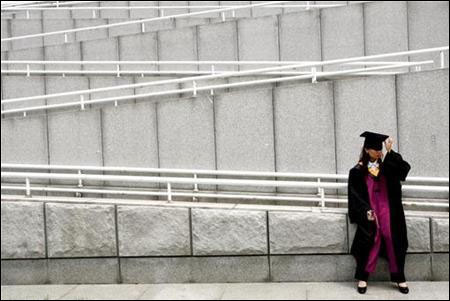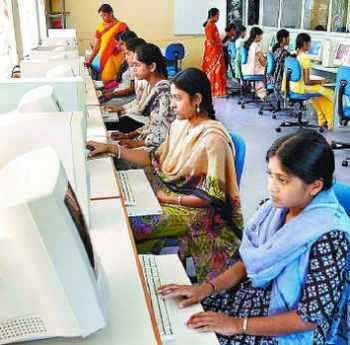 | « Back to article | Print this article |
Business schools get more women on board
Woman candidates aspiring for top business schools across the country have a reason to cheer.
Management institutes are putting in additional efforts to get more woman students on their campuses.
Major B-Schools, including the Indian Institutes of Management, Xavier Labour Relations Institute Jamshedpur, and Indian School of Business (ISB), have taken initiatives to bring more women on board.
Take IIM-Calcutta for example.
Click NEXT to read further. . .
Business schools get more women on board
Instead of having a group discussion as a criterion after the entrance examination, the institute now has a 'business situation written analysis', followed by a discussion.
According to Ashok Banerjee, dean (new initiatives and external relations) at IIM-C, woman students who often felt intimidated during group discussions are comfortable with the new format.
There is a four per cent increase in the number of woman students this year, compared to last year.
At XLRI, there is a 40 per cent increase in the number of woman students this year.
Its human resource specialisation field has more women than others.
Click NEXT to read further. . .
Business schools get more women on board
Soumendra Bagchi, XLRI admissions chairperson, said though no major steps were taken for this, everything else being the same, the panelists were asked to be sensitive to woman candidates and to those who show interesting/unique achievements.
Last year, XLRI had only 47 woman students.
IIM-Ahmedabad has seen almost a six per cent rise in woman students this year.
They form 17 per cent of the students this year, compared to 11 per cent earlier.
IIM-Bangalore has also seen a gradual increase in the number of women, which now stands at 100, an increase of about 17 per cent from last year.
M Jayadev, chairperson (admissions), attributes it to the fact that at the corporate level, woman candidates are being prioritised.
The image is for representation purpose only
Click NEXT to read further. . .
Business schools get more women on board
He added that academic records of candidates were also taken into account, and since women students usually performed well at the board exam level, this was an advantage for them.
Jayadev also explained they had made a conscious effort at IIM-B to assess the candidates at the personal interview level on a qualitative basis, apart from looking at the academic proficiency.
"While we are not compromising on the quality of our students, we are able to bring out an individual's personality," he said.
Click NEXT to read further. . .
Business schools get more women on board
IIM Lucknow has seen a 150 per cent rise in the number of woman students in the 2012-14 batch, compared to the 2011-13 batch.
As many as 166 woman students have been inducted this year in both the Post Graduate Programme in Management and PGP in Agri Business Management, with a total batch size of 453 students.
The 2011-13 batch had witnessed around 14 per cent women students, when the total batch size was 419.
The Indian School of Business is among the few institutes in India having a high number of woman students.
Click NEXT to read further. . .
Business schools get more women on board
A M Kannan, director, admissions and financial aid at ISB, said, "ISB's two campuses -- Hyderabad and Mohali -- have 216 woman students, out of a total class size of 767, accounting for a healthy 28 per cent of the class.
"The number of women at the school has been increasing steadily along with a corresponding increase in the class size."
He said unlike other B-schools, the average age of students at the ISB was 25-27.
"We believe this increase at the ISB is noteworthy, especially when we have been witnessing several woman students who are married and also those who have young children joining our PG programme," he added.
The image is for representation purpose only
Click NEXT to read further. . .
Business schools get more women on board
ISB encourages more women to apply to their full-time management programme.
It also encourages woman aspirants and students to meet woman alumni to get a better understanding of the opportunities that management education provides.
As a part of the professional and social clubs formed by its students, ISB has the Women in Business club.
WIB aims to connect with corporate woman leaders to empower the women student community, equip them to accomplish personal and professional goals, and contribute to society.
The school also has partnerships with companies -- such as Novartis that offer scholarships to women students.
Click NEXT to read further. . .
Business schools get more women on board
The Centre for Executive Education at ISB is working as an India academic partner with the Goldman Sachs Foun-dation on a global project, the '10,000 Women' Initiative'.
This initiative aims at providing business management education to deserving women, predominantly in developing and emerging markets.
Over the last three years, about 500 woman entrepreneurs have successfully completed the programme, not only in metros like Bengaluru, Delhi, Hyderabad and Mumbai, but also in smaller cities like Pune and Chandigarh.
At IIM-Kozhikode, the proportion of woman students is significantly on the higher side, with 28 per cent of students of the current batch being women.
Click NEXT to read further. . .
Business schools get more women on board
Rupesh Pati, the admissions chair at the institute, said, "IIM-K has been successful in achieving one of its goals of inclusive growth by consistently providing a higher representation of women candidates (of approximately 30 per cents) over the past couple of years.
"The social security provided by the presence of high woman representation might also be a factor leading to an increase in women preferring IIM-K as their destination for management education.
Hence, we feel as a community that this trend is there to continue in future."
Business schools are also looking at a better gender ratio.
Click NEXT to read further. . .
Business schools get more women on board
"We would like to see at least 20-25 per cent of the batch to comprise of women students. We are discussing various options to achieve this target.
"Our major constraint in admission is that we can minimally use subjective factors/asse-ssment, unlike in the USA.
"Our student selection criteria are required to be as objective as possible (due to RTI implications)," said Banerjee of IIM-C.
Another IIM official added this challenge would take a long time to be fulfilled, since, at the entrance exam level, there were few applications from woman aspirants.
"We would like to make a sea-change to the skewed gender ratio, but we also understand it will take another five to eight years to achieve the perfect balance."










